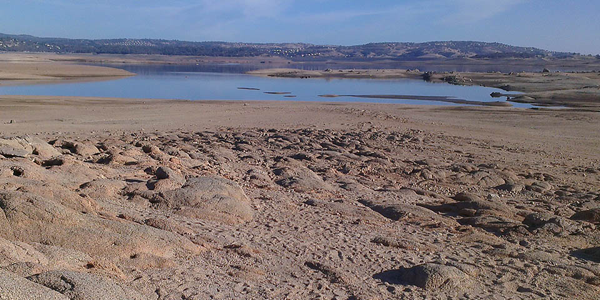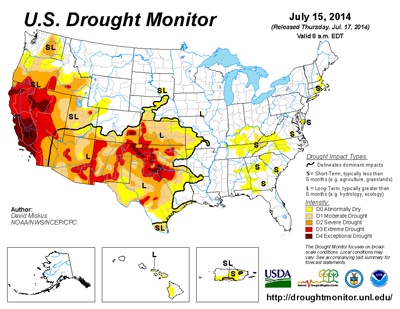Drinking Up Water Science During a Drought
For families living in drought conditions, careful monitoring of water usage is especially important. With hands-on science and engineering projects, students can investigate water-saving strategies and science and engineering related to water conservation.

Remember "Ring around the rosie" and "Rain, rain, go away"? Familiar with the "jinx machine" saying? You may recall these singsong chants from your own childhood or from watching your students on the schoolyard. Kids grow up repeating lots of songs and fun sayings—rhymes that, for better or worse, stick.
Today's California kids have added a new one to their repertoire—"If it's yellow, let it mellow. If it's brown, flush it down." It's catchy and a bit gross. It's got all the markings of classic potty talk. But these kids are talking about flushing strategies at school—in the name of water conservation.
When my elementary school student came home last year spouting "if it's yellow," it was new to me. It was a startling rhyme, but it does stick with you. As California's drought continued to worsen and the threat of a real water crisis grew, I started thinking more about the saying and discovered it is actually more than playground potty talk. As one strategy for helping reduce consumer water usage, the "if it's yellow" approach may have statistical merit.
Today, California's drought situation has gotten even drier, so much so that the state will soon be fining consumers for certain kinds of unnecessary water usage. Washing cars, spraying off sidewalks, and watering plants are all culprits for excess water usage. You probably won't find kids running through a free-flowing sprinkler system this summer in many California neighborhoods either.
Smart family water practices, like smart family electricity practices, can make a difference. Beyond flushing, there are lots of drips and drops of water in a typical day that the average family could save, and small-scale, house-by-house changes can add up to significant savings.
Water-saving Science
The threat of running out of water may seem distant and hard to fathom, but scientists are predicting California's drought is far from over. As families and schools talk with students about water conservation, it is important to think about household practices. Even tweaking simple routines like brushing teeth can make a difference. Do you leave the water on when you brush your teeth? How much water might you save if you turned it off while brushing and then turned it back on at the end?
These kinds of questions can lead to fun, informal science investigations at home or school and pose engaging real-world math problems for kids to work through. Collect the water during a normal teeth brushing session and measure it. Then collect the water during a session where the water is turned off during most of the two minutes of brushing and measure it. Multiply the amounts by the number of times a day each person in the house brushes. Multiply those numbers by days and then weeks.

Innovative Engineering and Design
California's water crisis is mounting, but California is not alone in its water shortage. The U.S. Drought Monitor map shows that roughly a third of the country is currently experiencing some level of drought.
As everyone from state officials to families to local farmers look for new approaches to improve water usage efficiency, stories of innovative solutions highlight the ways in which applied engineering and technology can make a difference at home and around the world. For example, in May, NPR reported on an unusual bamboo structure called the WarkaWater designed to gather water from the air.
As you and your kids take a closer look at how you use water in the house, think about things like indoor plants, running the dishwasher, rinsing dishes, washing clothes, filling the coffee pot, boiling pasta, and making ice. How much water do you really use? How many times is the water running unnecessarily or for longer than it should? Is there anyway to capture and reuse some of the household water that is otherwise wasted?
The following science and engineering projects guide students in thinking about and exploring different aspects of water conservation and drought:
- Water from Thin Air: Experimenting with Dew Traps: build and test dew traps to see how the design and surface area corresponds to the amount of water collected.
- Recycling Greywater: Can Plants Tolerate It?: can some household water that has been used once for washing be safely used again to water outdoor plants?
- Smart Watering: Adjusting Your Sprinklers for Optimal Soil Moisture: investigate to see if you can tweak the settings on a sprinkler system for more efficient usage.
- Dry Spells, Wet Spells: How Common Are They?: compare long-term precipitation patterns in different regions of the country and perform some statistical analysis to get a better understanding of precipitation cycles.
- Landscapes and Water Usage *: investigate the water requirements of different kinds of plants used in landscaping.
- Water-Wise: Building a Rainwater Collection System *: you shouldn't drink rainwater, but water collected this way might be put to other use. Can you engineer a collection system?
For more information about strategies you can use at home, see the Save Our Water site's collection of tips for indoor and outdoor water conservation.
Making Connections
Students in California (and in many other places in the U.S.) are hearing a lot about drought, but water is still available. In some areas around the world, access to water is even more seriously limited. Exploring water conservation, filtration, and decontamination strategies through hands-on science projects helps students better understand local and global water supply issues.
Projects ideas like these guide students in investigating strategies for decontaminating and desalinating water:
- Learn How to Disinfect Contaminated Water: recycle polyethylene terephthalate (PET) bottles and explore solar disinfection (SODIS) as a low-cost method for disinfecting contaminated water.
- From Contaminated to Clean: How Filtering Can Clean Water: investigate the effectiveness of a filter column for helping filter out impurities from water for drinking and other liquids.
- Solar-Powered Water Desalination: build and test a solar-powered device for desalinating water. What difference does the color of the bottom of the device make?
- From Brine to Beverage: Solar-Powered Salt Removal: make freshwater from saltwater using solar power and the water cycle.
Categories:
You Might Also Enjoy These Related Posts:
- 15 STEM Gifts & Science Kits You'll Feel Good About Giving
- 13 Boat Science and Submarine Science Projects and Experiments
- July 4th STEM! Summer Science Picks for Independence Day!
- 12 Science Kits for Summer Science Experiments and Discovery
- 15 Science Projects to Make and Give for Father's Day
- Ready, Set, Go! (Awesome Summer Science Experiments)
- Awesome Summer Science Experiments
- 10 STEM Activities with Cardboard Tubes









